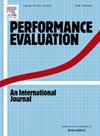Symbolic state-space exploration meets statistical model checking
IF 0.8
4区 计算机科学
Q4 COMPUTER SCIENCE, HARDWARE & ARCHITECTURE
引用次数: 0
Abstract
Efficient reachability analysis, as well as statistical model checking have been proposed for the evaluation of Hybrid Petri nets with general transitions (HPnGs). Both have different (dis-)advantages. The performance of statistical simulation suffers in large models and the number of required simulation runs to achieve a relatively small confidence interval increases considerably. The approach introduced for analytical reachability analysis of HPnGs, however, becomes infeasible for a large number of random variables. To overcome these limitations, this paper applies statistical model checking (SMC) for a stochastic variant of the Signal Temporal Logic (STL) to a pre-computed symbolic state-space representation of HPnGs, i.e., the Parametric Location Tree (PLT), which has previously been used for model checking HPnGs. Furthermore, we define how to reduce the PLT for a given state-based and path-based STL property, by introducing a three-valued interpretation of a given STL property for every location of the PLT. This paper applies learning in the presence of nondeterminism and considers four different scheduler classes. The proposed improvement is especially useful if a large number of training runs is necessary to optimize the probability that a given STL property holds. A case study on a water tank model shows the feasibility of the approach, as well as improved computation times, when applying the above-mentioned reduction for varying time bounds. We validate our results with existing analytical and simulation tools, as applicable for different types of schedulers.
符号状态空间探索与统计模型检查的结合
为评估具有一般转换的混合 Petri 网(HPnGs),人们提出了高效的可达性分析和统计模型检查。这两种方法都有不同的优势。在大型模型中,统计模拟的性能会受到影响,而且要达到相对较小的置信区间所需的模拟运行次数也会大大增加。然而,为分析 HPnGs 的可达性而引入的方法对于大量随机变量来说是不可行的。为了克服这些局限性,本文将信号时态逻辑(STL)随机变体的统计模型检查(SMC)应用于 HPnGs 的预计算符号状态空间表示法,即参数位置树(PLT)。此外,通过为 PLT 的每个位置引入对给定 STL 属性的三值解释,我们定义了如何针对给定的基于状态和基于路径的 STL 属性缩小 PLT。本文将学习应用于存在非确定性的情况,并考虑了四种不同的调度器类别。如果需要大量的训练运行来优化给定 STL 属性成立的概率,那么所提出的改进方法就特别有用。一项关于水箱模型的案例研究表明了该方法的可行性,以及在应用上述针对不同时间界限的缩减方法时计算时间的改进。我们利用适用于不同类型调度器的现有分析和仿真工具验证了我们的结果。
本文章由计算机程序翻译,如有差异,请以英文原文为准。
求助全文
约1分钟内获得全文
求助全文
来源期刊

Performance Evaluation
工程技术-计算机:理论方法
CiteScore
3.10
自引率
0.00%
发文量
20
审稿时长
24 days
期刊介绍:
Performance Evaluation functions as a leading journal in the area of modeling, measurement, and evaluation of performance aspects of computing and communication systems. As such, it aims to present a balanced and complete view of the entire Performance Evaluation profession. Hence, the journal is interested in papers that focus on one or more of the following dimensions:
-Define new performance evaluation tools, including measurement and monitoring tools as well as modeling and analytic techniques
-Provide new insights into the performance of computing and communication systems
-Introduce new application areas where performance evaluation tools can play an important role and creative new uses for performance evaluation tools.
More specifically, common application areas of interest include the performance of:
-Resource allocation and control methods and algorithms (e.g. routing and flow control in networks, bandwidth allocation, processor scheduling, memory management)
-System architecture, design and implementation
-Cognitive radio
-VANETs
-Social networks and media
-Energy efficient ICT
-Energy harvesting
-Data centers
-Data centric networks
-System reliability
-System tuning and capacity planning
-Wireless and sensor networks
-Autonomic and self-organizing systems
-Embedded systems
-Network science
 求助内容:
求助内容: 应助结果提醒方式:
应助结果提醒方式:


